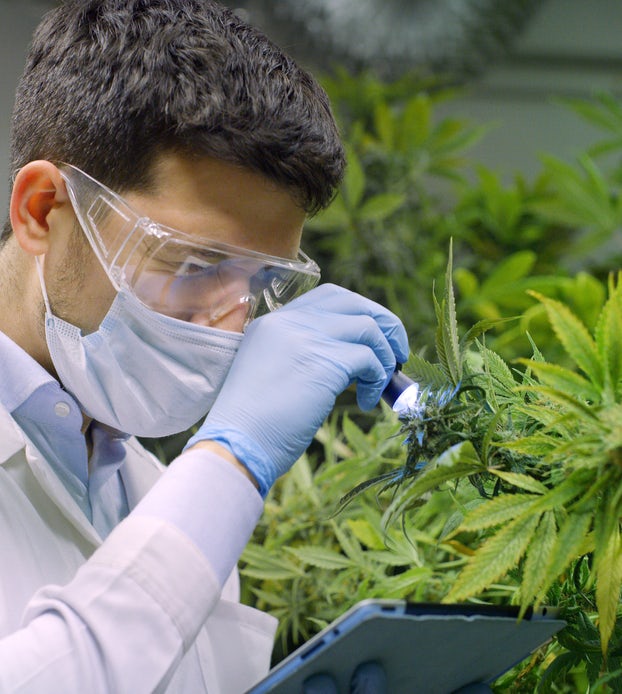Our bodies have a built-in framework ready to accept the active molecules in cannabis, like THC. This network is called the endocannabinoid system (ECS), and it’s a fundamental part of our biology. In fact, all vertebrates share a variation of this system, from dogs and cats to fish and birds –they all have an endocannabinoid system. This could lead one to believe we might actually be “hardwired” to consume cannabis, but this is not actually the case. Rather, we humans identified the cannabis plant as a highly useful herb, carried it with us across the world, and incorporated its many uses into our lives. 1
Befores prohibition began in the 20th century, cannabis was legal to grow and use, and was even being prescribed by doctors in America from the 1850s to the 1940s. Moreover cannabis has been used medicinally and recreationally for thousands of years. However, analyses of pollen distribution have indicated that the cannabis plant predates the human species; in fact, studies have estimated that the first cannabis plants emerged over 20 million years ago.2 3
The first identified use of cannabis dates back about 12,000 years, at the end of the last Ice Age. Humans uncovered the potential of cannabis to be useful for food, fiber, and spirituality and began cultivation and domestication. People in Asia were some of the first to take advantage of the plant, which provides strong fibrous materials ideal for various purposes like making rope and nets. 4
Through the winding paths of the Silk Road, cannabis made its way across Asia and eventually to other regions like India, Africa, and even Europe. Despite not being used as an intoxicant in Europe until more recently, cannabis has been used for food and fiber since Roman times. 5
William O’Shaughnessy, a medical doctor who had practiced medicine in british-occupied India, is credited as the first to bring medical cannabis over to Europe. He began treating patients with cannabis extracts and wrote of its many clinical applications. From there, cannabis became an important therapeutic tool in Western medical practice, at least until prohibition began in the early 19th century. 6
But of course, cannabis is not solely used as medicine. Its intoxicating effects have been enjoyed for thousands of years. Many cultures incorporated its use into religious practices and other traditional rituals, and its effects are still enjoyed across the world. 7
What’s the difference between endocannabinoids and phytocannabinoids?
The ECS has been part of mammalian biology for 600 million years – that’s quite a long time before the emergence of the cannabis plant and an incredibly long time before we humans entered the picture. The ECS likely developed as an evolutionary advantage to secure vertebrate survival. This system is just as, or even more, vital to our daily functioning than any other system in the body. 8
Endogenous cannabinoids like AEA and 2-AG regulate key body functions through their effects on receptors like CB1 and CB2, as well as many others. The cannabis and hemp plants produce exogenous cannabinoids, or phytocannabinoids, that attach themselves to these receptors and others to mimic the effects of endogenous cannabinoids. 9
The ECS is modulatory in nature and helps bring us toward homeostasis, a state of balance and a return to “normal” functioning. We needed this system to survive challenges of nature – from hunting to chasing away predators to protecting ourselves against the elements. While those challenges look different in modern society, we still very much rely on the ECS today.
The ECS long predates humanity and cannabis cultivation, suggesting this system has less to do with cannabis and more to do with complex life on earth. Additionally, most archaeological evidence suggests most of our earliest human ancestors did not live in the part of the world where cannabis grew wildly. Therefore, humans didn’t evolve to consume cannabis. Rather, thanks to the vast uses of the cannabis plant, we domesticated cannabis over time in the same manner as other plants that we consume every day–like broccoli, cauliflower, or asparagus.
That doesn’t mean cannabis is not incredibly important to our culture. According to a critical review by Sunil Aggarwal, MD, PhD, “When gathering evidence to address behavioral questions surrounding human consumption and production of potentially psychoactive cannabis preparations, it is absolutely essential that this long, co-evolutionary arc of human history with this cannabinergic plant be appreciated.” 10
Is cannabis essential for good health?
As of 2019, about 200 million people used cannabis worldwide, and there are nearly 8 billion people on earth. So, even though it’s a widely popular plant, cannabis is clearly not for everyone, nor is it essential for our health. 11
As with any bioactive substance, genetic differences contribute to how people respond. One such example is coffee. Some people dislike coffee because the caffeine and its other compounds make them too jittery, while others feel that it makes them more alert and facilitates productivity. 12

Every person reacts to cannabis differently – and not everyone enjoys it or can even feel its effects. If we were hardwired to consume cannabis, this likely would not be the case. Scientists have identified several genetic variations that contribute to how each person reacts to cannabis, some of these being genes that affect metabolism. 13 14
Cannabis can also cause unwanted side effects like paranoia, dizziness, and light-headedness. In some people, it can cause cannabinoid hyperemesis syndrome, characterized by extreme nausea and vomiting. This isn’t at all specific to humans – data have shown a variety of responses to cannabis across other vertebrates. For example, horses have been treated with low-dose cannabis for colic for many years. And while CBD has been found to be an effective treatment for some conditions in cats and dogs, THC is not recommended because it causes toxicity. 15 16 17
Clinical endocannabinoid deficiency
While people do not need to consume cannabis, those with certain conditions may benefit greatly from its medicinal properties. Ethan Russo, MD, a prominent cannabis researcher and educator, proposed that some people in fact have lower levels of endocannabinoids, causing their ECS not to function properly. In this case, people with what he calls Clinical Endocannabinoid Deficiency (CED) could greatly benefit from phytocannabinoid use. 18
Russo posits that conditions like migraine, fibromyalgia, and irritable bowel syndrome may result from low levels of endogenous cannabinoids. These conditions are of course complex, and, while cannabinoids have great utility in the clinical setting, CED is not yet a widely accepted diagnosis but rather a theory requiring further research.
Bottom line
Even if humans are not “hard-wired” to use cannabis, the plant also contains other compounds like terpenes and flavonoids that are nutritious and support overall health. But these substances can also be found in a variety of foods and herbs, further dispelling the idea that we as a species need cannabis as part of our diet or routine.
If you enjoy cannabis, go ahead, and keep using it, especially if you rely on it to treat a certain medical condition. If you feel comfortable, tell your doctor because cannabis can interact with certain medications and some health conditions. Those who aren’t interested however are not “missing” out on anything essential, but they may be missing out on some of the benefits this multipurpose herb can provide.
Sources
- Silver RJ. The Endocannabinoid System of Animals. Animals (Basel). 2019;9(9):686. Published 2019 Sep 16. doi:10.3390/ani9090686
- McPartland, John & Hegman, William & Long, Tengwen. (2019). Cannabis in Asia: its center of origin and early cultivation, based on a synthesis of subfossil pollen and archaeobotanical studies. Vegetation History and Archaeobotany. 28. 10.1007/s00334-019-00731-8.
- Bridgeman MB, Abazia DT. Medicinal Cannabis: History, Pharmacology, And Implications for the Acute Care Setting. P T. 2017;42(3):180-188.
- Crocq MA. History of cannabis and the endocannabinoid system. Dialogues Clin Neurosci. 2020;22(3):223-228.
- Mercuri, Anna Maria & Accorsi, Carla Alberta & Mazzanti, Marta. (2002). The long history of Cannabis and its cultivation by Romans in Central Italy (pollen records from Lago Albano and Lago di Nemi). Vegetation History and Archaeobotany. 11. 263-276. 10.1007/s003340200039.
- Crocq MA. History of cannabis and the endocannabinoid system. Dialogues Clin Neurosci. 2020;22(3):223-228.
- Ren M, Tang Z, Wu X, et al. The origins of cannabis smoking: Chemical residue evidence from the first millennium BCE in the Pamirs. Sci Adv. 2019;5(6):eaaw1391. Published 2019 Jun 12. doi:10.1126/sciadv.aaw1391
- McPartland JM. The endocannabinoid system: an osteopathic perspective. J Am Osteopath Assoc. 2008;108(10):586-600. doi:10.7556/jaoa.2008.108.10.586
- Gertsch J. Cannabimimetic phytochemicals in the diet – an evolutionary link to food selection and metabolic stress adaptation?. Br J Pharmacol. 2017;174(11):1464-1483. doi:10.1111/bph.13676
- Aggarwal S. K. (2013). ‘Tis in our nature: taking the human-cannabis relationship seriously in health science and public policy. Frontiers in psychiatry, 4, 6. https://doi.org/10.3389/fpsyt.2013.00006
- United Nations. “World Drug Report 2021.” Available at: https://www.unodc.org/res/wdr2021/field/WDR21_Booklet_3.pdf Accessed: February 1, 2022
- Yang A, Palmer AA, de Wit H. Genetics of caffeine consumption and responses to caffeine. Psychopharmacology (Berl). 2010;211(3):245-257. doi:10.1007/s00213-010-1900-1
- Murphy T, Matheson J, Mann RE, et al. Influence of Cannabinoid Receptor 1 Genetic Variants on the Subjective Effects of Smoked Cannabis. Int J Mol Sci. 2021;22(14):7388. Published 2021 Jul 9. doi:10.3390/ijms22147388
- Gasse A, Vennemann M, Köhler H, Schürenkamp J. Toxicogenetic analysis of Δ9-THC-metabolizing enzymes. Int J Legal Med. 2020;134(6):2095-2103. doi:10.1007/s00414-020-02380-3
- LaFrance EM, Stueber A, Glodosky NC, Mauzay D, Cuttler C. Overbaked: assessing and predicting acute adverse reactions to Cannabis. J Cannabis Res. 2020;2(1):3. Published 2020 Jan 2. doi:10.1186/s42238-019-0013-x
- DeVuono MV, Parker LA. Cannabinoid Hyperemesis Syndrome: A Review of Potential Mechanisms. Cannabis Cannabinoid Res. 2020;5(2):132-144. Published 2020 Jun 5. doi:10.1089/can.2019.0059
- De Briyne N, Holmes D, Sandler I, et al. Cannabis, Cannabidiol Oils and Tetrahydrocannabinol-What Do Veterinarians Need to Know?. Animals (Basel). 2021;11(3):892. Published 2021 Mar 20. doi:10.3390/ani11030892
- Russo EB. Clinical Endocannabinoid Deficiency Reconsidered: Current Research Supports the Theory in Migraine, Fibromyalgia, Irritable Bowel, and Other Treatment-Resistant Syndromes. Cannabis Cannabinoid Res. 2016;1(1):154-165. Published 2016 Jul 1. doi:10.1089/can.2016.0009
Sign up for bi-weekly updates, packed full of cannabis education, recipes, and tips. Your inbox will love it.

 Shop
Shop Support
Support

















